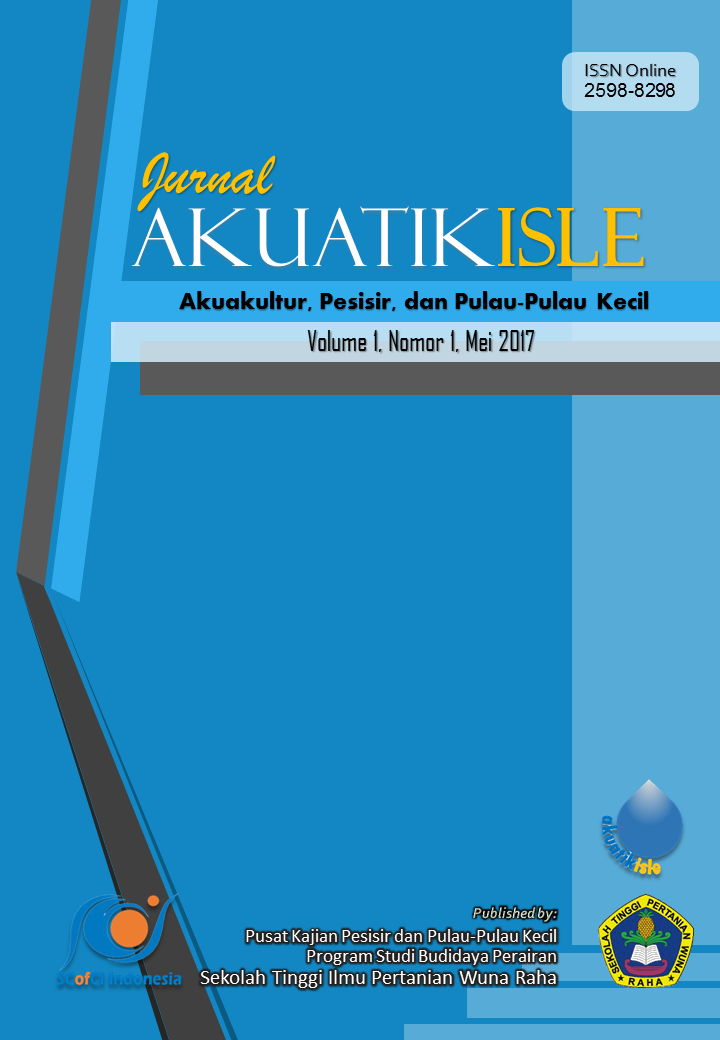Akuatikisle: Jurnal Akuakultur, Pesisir dan Pulau-Pulau Kecil
Full Length Article
Effect of inorganic fertilizer (NPK+Silicate) with different dosage to Skeletonema costatum density on hatchery of tiger shrimp
Pengaruh pemberian pupuk anorganik (NPK+Silikat) dengan dosis berbeda terhadap kepadatan Skeletonema costatum pada pembenihan udang windu
Highlights
Generate NLP AI by Wizdam ID.
Abstract
Skeletonema costatum one type of phytoplankton commonly cultivated in the shrimp hatchery (Penaeus monodon Fabr.). Plankton S. costatum has a high nutrient content, small size is used as a natural feed of tiger shrimp larvae, especially in the zoea to mysis stadia. The aim of this research is to know the effect of inorganic fertilizer (NPK+Silicate) with dosage of 5 ppm, 15 ppm and 20 ppm to the density of S. costatum on tiger shrimp. The study was conducted for 2 weeks in July 2011 at UPTD Balai Benih Ikan Pantai Muna, Ghonebalano village, Duruka district, Muna regency, Southeast Sulawesi. The experiment used a 3-liter volume on stoples, a salinity water of 20 ppm. The study used Completely Randomized Design (RAL) with NPK and Silicate treated fertilizer with 5 ppm, 10 ppm (control), 15 ppm and 20 ppm with 3 replications. The initial density of S. costatum was 10,000 cells mL-1 per unit. The data were analyzed by ANOVA using IBM SPSS Statistic 22. The results showed that inorganic fertilizer application (NPK+Silicate) with different dose gave a very real effect on the density of S. costatum cells. Treatment of 15 ppm fertilizer dosage was significantly different with control and other treatment, average cell density was 121,000 cells mL-1. Based on cell growth, the 15 ppm fertilizer dosage has the best growth with an average cell increase of 1,2705 cells mL-1 day-1.
Abstract
Skeletonema costatum salah satu jenis fitoplankton yang umum dibudidayakan dalam pembenihan udang windu (Penaeus monodon Fabr.). Plankton S. costatum memiliki kandungan nutrien tinggi, ukuran kecil digunakan sebagai pakan alami larva udang windu, khususnya pada stadia zoea sampai mysis. Penelitian bertujuan untuk mengetahui pengaruh pemberian pupuk anorganik (NPK+Silikat) dengan dosis 5 ppm, 15 ppm, dan 20 ppm terhadap tingkat kepadatan S. costatum pada udang windu. Penelitian dilaksanakan selama 2 minggu pada bulan Juli 2011 di Balai Benih Ikan Pantai Muna, Desa Ghonebalano, Kecamatan Duruka, Kabupaten Muna, Sulawesi Tenggara. Percobaan menggunakan wadah stoples volume 3 L, media air laut salinitas 20 ppm. Penelitian menggunakan Rancangan Acak Lengkap (RAL) dengan perlakuan pupuk NPK dan Silikat yang dilarutkan dengan dosis 5 ppm, 10 ppm (Kontrol), 15 ppm dan 20 ppm dengan tiga kali ulangan. Kepadatan awal S. costatum 10.000 sel/mL setiap unit percobaan. Data dianalisis ANOVA menggunakan IBM SPSS Statistic 22. Hasil penelitian menunjukkan pemberian pupuk anorganik (NPK+Silikat) dengan dosis berbeda memberi pengaruh yang sangat nyata terhadap tingkat kepadatan sel S. costatum. Perlakuan dosis pupuk 15 ppm sangat berbeda nyata terhadap kontrol dan perlakuan lainnya, kepadatan sel rata-rata sebanyak 121.000 sel mL-1. Berdasarkan pertumbuhan selnya, pelakuan dosis pupuk 15 ppm memiliki pertumbuhan terbaik dengan pertambahan sel rata-rata sebesar 1,2705 sel mL-1 hari-1.
Keywords
Introduction
Section snippets
Material and Methods
Materials and methods from the full-text PDF of this article cannot be displayed.
Results
Results from the full-text PDF of this article cannot be displayed.
Discussion
Discussion from the full-text PDF of this article cannot be displayed.
Conclusions
Conclusions from the full-text PDF of this article cannot be displayed.
Acknowledgment
Acknowledgment from the full-text PDF of this article cannot be displayed.
Funding Information
Program Studi Budidaya Perairan, Sekolah Tinggi Ilmu Pertanian Wuna Raha
Competing interest
The authors declare that they have no known competing financial interests or personal relationships that could have appeared to influence the work reported in this paper.
Conflict of interest
The authors declare that the research was conducted in the absence of any commercial or financial relationships that could be construed as a potential conflict of interest.
Ethical approval acknowledgements
No ethical approval required for this article. All procedures followed were in accordance with the ethical standards of the responsible committee on human experimentation (institutional and national) and with the Helsinki Declaration of 1975, as revised in 2008 (5)
Supplementary files
Data sharing not applicable to this article as no datasets were generated or analysed during the current study, and/or contains supplementary material, which is available to authorized users.
Bibliographic Information
Cite this article as:
-
Submitted
4 March 2017 -
Revised
14 April 2017 -
Accepted
27 April 2017 -
Published
27 May 2017 -
Version of record
3 June 2017 -
Issue date
31 May 2017
-
Academic subject
Fisheries; Fisheries Science
Copyright
One of the factors that affect the growth of tiger shrimp is the quality of feed. Nutrient content in feed such as protein, carbohydrate and fat, generally used as a parameter of feed quality. Feed consumed by shrimp is not all digested, one of which depends on the enzymatic ability of the shrimp digestive tract. The use of probiotic bacteria in addition to having the ability to reduce colonies, inhibit the growth of pathogenic bacteria, and neutralize water quality, probiotic bacteria can help digestibility of the intestine.
See Usman & Rochmady.
Copyright © 2017 Fitriani, Fendi, & Rochmady. Sangia Research Media and Publishing. Production and hosting by Sangia (SRM™).  This work is licensed under a Creative Commons Attribution-ShareAlike 4.0 International License.
This work is licensed under a Creative Commons Attribution-ShareAlike 4.0 International License.
Disclaimer: All claims expressed in this article are solely those of the authors and do not necessarily represent those of their affiliated organizations, or those of the publisher, the editors and the reviewers. Any product that may be evaluated in this article or claim that may be made by its manufacturer is not guaranteed or endorsed by the publisher.



